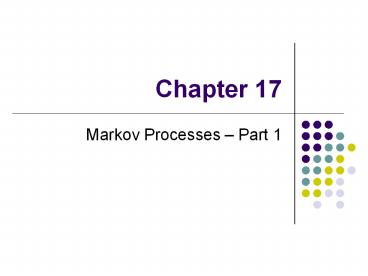Markov Processes - PowerPoint PPT Presentation
1 / 24
Title:
Markov Processes
Description:
... evolution of systems over repeated trials or sequential time periods or stages. ... and can pass from one state to another each time step according to fixed ... – PowerPoint PPT presentation
Number of Views:31
Avg rating:3.0/5.0
Title: Markov Processes
1
Chapter 17
- Markov Processes Part 1
2
Markov Processes
- Markov process models are useful in studying the
evolution of systems over repeated trials or
sequential time periods or stages. - Examples
- Brand Loyalty
- Equipment performance
- Stock performance
3
Markov Processes
- When utilized, they can state the probability of
switching from one state to another at a given
period of time - Examples
- The probability that a person buying Colgate this
period will purchase Crest next period - The probability that a machine that is working
properly this period will break down the next
period
4
Markov Processes
- A Markov system (or Markov process or Markov
chain) is a system that can be in one of several
(numbered) states, and can pass from one state to
another each time step according to fixed
probabilities. - If a Markov system is in state i, there is a
fixed probability, pij, of it going into state j
the next time step, and pij is called a
transition probability.
5
Markov Processes
- A Markov system can be illustrated by means of a
state transition diagram, which is a diagram
showing all the states and transition
probabilities probabilities of switching from
one state to another.
6
Transition Diagram
.2
.4
1
2
.8
.35
.50
.65
What does the diagram mean?
3
.15
7
Transition Matrix
- The matrix P whose ijth entry is pij is called
the transition matrix associated with the system.
- The entries in each row add up to 1.
- Thus, for instance, a 2 2 transition matrix P
would be set up as shown at the right.
To
1 2
1 P11 P12
2 P21 P22
From
8
Diagram Matrix
.2
.4
1
2
.8
To
.35
.50
1 2 3
1 .2 .8 0
2 .4 0 .6
3 .5 .35 .15
.6
3
From
.15
9
Vectors Transition Matrix
- A probability vector is a row vector in which the
entries are nonnegative and add up to 1. - The entries in a probability vector can represent
the probabilities of finding a system in each of
the states.
10
Probability Vector
- Let P
.2 .8 0
.4 0 .6
.5 .35 .15
11
State Probabilities
- The state probabilities at any stage of the
process can be recursively calculated by
multiplying the initial state probabilities by
the state of the process at stage n.
12
State Probabilities
?i (n) Probability that the system is in state i in period n
?(n) ?1 (n) ?2 (n) Denotes the vector of state probabilities for the system in period n
?(n1) ?(n) P State probabilities for period n1 can be found by multiplying the known state probabilities for period n by the transition matrix
13
State Probabilities
- Example
- ?(n) ?1 (n) ?2 (n)
- ?(1) ?(0) P
- ?(2) ?(1) P
- ?(3) ?(2) P
- ?(n1) ?(n) P
14
Steady State Probabilities
- The probabilities that we approach after a large
number of transitions are referred to as steady
state probabilities. - As n gets large, the state probabilities at the
(n1)th period are very close to those at the nth
period.
15
Steady State Probabilities
- Knowing this, we can compute steady state
probabilities without having to carry out a large
of calculations
?(n) ?1 (n) ?2 (n)
?1 (n1) ?2 (n1) p11 p12
?1 (n) ?2 (n) p21 p22
16
Example
- Henry, a persistent salesman, calls North's
Hardware Store once a week hoping to speak with
the store's buying agent, Shirley. If Shirley
does not accept Henry's call this week, the
probability she will do the same next week (and
not accept his call) is .35. On the other hand,
if she accepts Henry's call this week, the
probability she will not accept his call next
week is .20.
17
Example Transition Matrix
Next Weeks Call
Refuses Accepts
Refuses .35 .65
Accepts .20 .80
This Weeks Call
18
Example
- How many times per year can Henry expect to talk
to Shirley? - Answer To find the expected number of accepted
calls per year, find the long-run proportion
(probability) of a call being accepted and
multiply it by 52 weeks.
19
Example
- Let ?1 long run proportion of refused calls
- ?2 long run proportion of accepted calls
- Then,
.35 .65 ?1 ?2
.20 .80 ?1 ?2
20
Example
- ????? ????? ?? (1)
- ????? ????? ?? (2)
- ?? ?? 1 (3)
- Solve for ?? and ??
21
Example
22
(No Transcript)
23
(No Transcript)
24
- The probability of the system being in a
particular state after a large number of stages
is called a steady-state probability.































